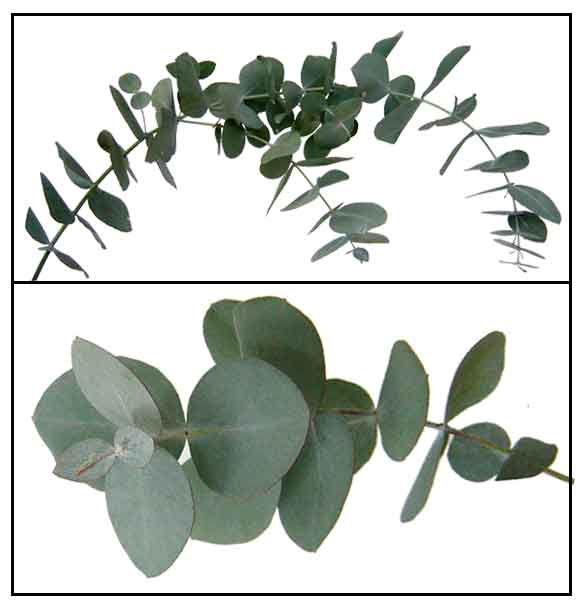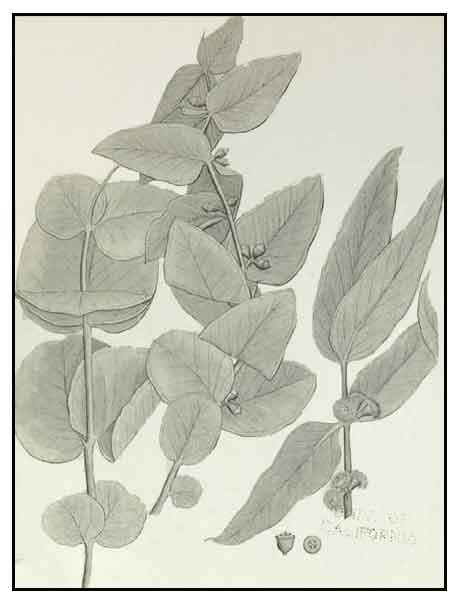|
 Botany Botany
Spiral eucalyptus is a small tree with reddish
brown, drooping branches. Leaves are opposite, stiff, leathery,
silvery green to grayish blue, rounded, up to 7 centimeters across when young,
becoming ovate to lanceolate, with a yellow midrib when mature.
Distribution
- Native to New South Wales and Victoria, Australia.
-
Recently introduced with
limited distribution and cultivation.
-
Usually planted as a garden
plant.
Constituents
- Yields essential oils, most effective is 1,8-cineole and anisole.
- Study evaluated the essential oil from different plant parts - leaves, flowers, and fruits. 1,8-Cineole was the main compound from leaves in spring, and flowers and fruits in winter. Other compounds in the aerial parts were a-pinene, limonene, a-terpineol, and a-terpinyl acetate.
- GC-MS analysis of essential oil yielded main components of 1,8-cineole (61%) and camphene (15.13%). An EtOAc-F yielded polyphenols, flavonoids, quinones, terpenoids, alkaloids, and tannins. (see study below) (7)
Properties
- Astringent and antiseptic.
- Studies have suggested repellent, fumigant, insecticidal, antimicrobial, larvicidal, pediculicidal properties.
Parts used
Leaves.
Uses
Folkloric
- Not widely used as a medicinal
plant in the Philippines. But as with other eucalyptus pants, is
used as an antiseptic and deodorant.
- Used for infections, colds, sore throats, flu, bronchitis, pneumonia,
neuralgia and variety of skin infections.
- Decoction of leaves as tea for cough, asthma, hoarseness, fevers.
Extraction of oil
Boil mature leaves in water,
condensing the vapor to recover the oil. Eucalyptus globulus yields
less oil than the other varieties used for commercial production of
medicinal grade oils.
 Studies Studies
• In South America,
being studied for its use as a fumigant and repellant and head lice
control. (Journal of Medical Entomology / Article: pp. 889–895)
• Chemical composition of the
essential oil of nine Eucalyptus species growing in Morocco:
The species studied included E. cinerea. All species were found to possess
an oil rich in 1,8-cineole, exceeding 80% in E. cinerea. (1)
• Fumigant / Repellent / Anti-Lice : In an Argentinian study of the fumigant and repellent properties of 16 essential oils and 21 chemical components against permethrin-resistant head lice, from 16 plants in Argentina, the most effective oil was the native M cisplatensis followed by E cinerea. (2)
• Insecticidal Activity / Housefly: In a study in Argentina of 12 essential oils and 17 individual terpenes for insecticidal activity against the house fly Musca domestica, Citrus sinensis was the most potent insecticide followed by C aurantium and Eucalyptus cinerea. (3)
• Larvicidal / Aedes Aegypti / Essential Oil: Study evaluated the homeopathic and larvicide effect of E. cinerea essential oil on Aedes aegypti. It showed a high larvicide effect. Results showed the essential oil was highly promisng for a public health system for control of A. aegypti. (4)
• Essential Oil from Different Plant Parts / Antimicrobial: Study showed 1,8-Cineole was the main compound from leaves in spring, and flowers and fruits in winter. Other compounds in the aerial parts were a-pinene, limonene, a-terpineol, and a-terpinyl acetate. The essential oil showed antimicrobial activities against bacteria (Strep pyogenes, Staph aureus, Pseudomonas aeruginosa) and yeasts (Candida albicans). E. cinerea can be employed as a source of 1,8-cineole, since the aerial parts (leaves, flowers, and fruits) show to be rich in these compound in al seasons of the year. (5)
• Antibacterial Activity / Curative Biocontrol for Crown Gall Disease / Essential Oil: An EtOAc-F exhibited potent antibacterial activity attributed to polyphenols, flavonoids, quinones, terpenoids, alkaloids, and tannins, with lowest MIC and MBC of 0.312 mg/mL and 2.5 mg/mL, respectively. GC-MS analysis yielded significant antibacterial compounds including gallic acid (7.18%), shikimic acid (5.07%), and catechin (3.12%). In plant experiments, EtOAc-F significantly reduced gall weights. Results suggest a potential as curative biocontrol agent for crown gall disease. (7)
• Optimization of E. cinerea Oil Distillation: 1,8-Cineole is an ecofriendly compound with potential to replace ozone depleting industrial solvents. Study reports on the optimized process parameters for hydrodistillation and production of essential oil enriched with 1,8-cineole from Eucalyptus cinerea. GC-MS analysis showed oil produced from fresh foliage yielded higher 1,8-cineole content (84.4%) than dried foliage (77.6%). Other major constituents were limonene and a-terpineol. (8)
• Antioxidant / Antimicrobial /
Volatile Oil: Yield of volatile oil hydrodistilled from juvenile leaves and stems was 4.5 and 0.5%, respectively, with 1,8-cineole as the major oxygenated monoterpenoid (84.55% and 60.15% in the juvenile leaves and stems, respectively.) Leaf oil showed more potent antibacterial activity than the stems. MIC of juvenile leaves against E. coli, P. aeruginosa, S. faecalis, C. albicans, and A. flavus were 5.2, 5.6, 4, 4.8, and 12.8 µg/ml, respectively. Juvenile leaf oil also showed more active antioxidant activity. (9)
• Eucalyptus Oil Poisoning: Study reports on 2 pediatric cases of status epilepticus associated with accidental ingestion of Eucalyptus oil. Severe toxicity following ingestion is well-documented, but public awareness is lacking. Symptoms range from minor poisoning (ataxia, vomiting, abdominal pain) to major poisoning with coma. CNS symptoms may develop within 10 minutes of ingestion. In adults, death is commonly seen after ingestion of 30 ml. There is no specific antidote. Management of eucalyptus oil poisoning is main supportive and symptomatic. (12)
• Side Effects: Eucalyptus leaf is LIKELY SAFE in the small amounts found in foods. There is not enough information on on the safety of oral supplements that contain large amounts of eucalyptus leaf. • Eucalyptol, a chemical found in eucalyptus oil, is POSSIBLY SAFE when taken by mouth up to 12 weeks. • Undiluted eucalyptus oil is POSSIBLY UNSAFE when applied to the skin. • Undiluted eucalyptus oil is LIKELY UNSAFE when taken by mouth. • The oil should not be used during pregnancy or breast feeding. • The oil is LIKELY UNSAFE FOR children, by mouth or applied to the skin. (13)
• Interactions: (1) Eucalyptus interacts with medications changed by the liver (cytochrome P450 [CYP1A2, CYP2C19, CYP2C9, CYP3A4]) subtrates. • Eucalyptus leaf extracts may decrease blood sugar, and should be used with caution in patients on diabetic hypoglycemic medications. (13)
Toxicity concerns
- There are over 700 species of eucalyptus trees.
- Use of oil distilled from leaves have been reported in Australian aboriginal medicine.
- In present day use, eucalyptus is used in commercial cough lozenges and mouthwash.
- In large amounts, eucalyptus leaves and bark are considered poisonous, and can cause vomiting, diarrhea, and even coma.
- Oil is toxic, and should not be ingested in any amount.
- Children should not ingest eucalyptus in any form. Over the age of two, eucalyptus rubs may be safe; but best to consult the physician. (11)
- As little as 3.5 ml of undiluted oil can be fatal. (13)
- Eucalyptol, an essential oil from leaves, consumed in small quantities by humans, are unlikely to be harmful. The NIH recognizes eucalyptus oil and leaves can be safely used in various therapies, including vaporizer treatments to cure congestion. The NIH cautions, eucalyptus oil should be diluted before oral consumption or skin application. (While domesticated animals should not be exposed to eucalyptus leaves and oils, the Australian koala is reported to subsist entirely on eucalyptus, eating pounds of the nutrient-poor plant each day.) (14)
Availability
- Wild-crafted.
- Essential oils in the cybermarket.
|


 Botany
Botany Studies
Studies

